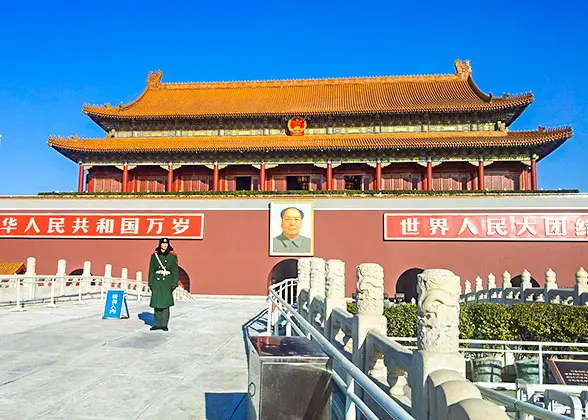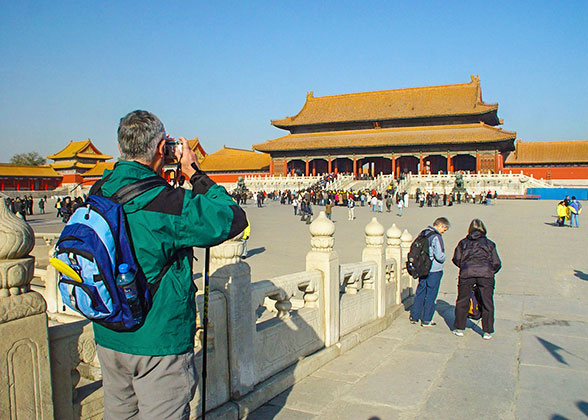BEIJING ― The plush lobby of Beijing's Kerry Center Hotel is usually crowded with foreign guests, many of them listening to jazz and sipping martinis in Centro, the hotel's fashionable bar, or lining up for taxis after dinner at the Horizon restaurant.
But Thursday evening, Centro had only a sprinkling of guests in a hotel whose occupancy rate is typically close to 100 percent this time of year. That night, the duty manager, said it was 63 percent.
"Something strange has been going on," said Sun Yin, the duty manager. "I really don't know what happened."
With the Beijing Olympics less than two months away, hotel operators, travel agencies, and foreign businessmen say new Chinese visa restrictions are proving bad for business, casting a pall over Beijing during what was supposed to be a busy and jubilant tourist season leading up to the Olympic Games.
Chinese authorities acknowledged putting new visa restrictions in place in May ― after foreign embassies reported fewer visas being granted and tighter, sometimes seemingly arbitrary, restrictions. The government did not release guidelines detailing the changes in policy; it often does not. But a foreign ministry spokesman, Qin Gang, said in May that they would be temporary.
On Monday, Hu Bin, a visa official at the foreign ministry, said the ministry had no statistics on the number of visa denials, but that the new policies were put in place for "security considerations."
Travel business analysts had forecast that the Games would bring 500,000 foreign visitors and an extra $4.5 billion in revenue to Beijing this summer. But now, even though some five-star hotels are fully booked for the Olympics, many economists are beginning to doubt the city will get the kind of economic windfall it was hoping for.
Many hotels in Beijing are struggling to find guests; some large travel agencies have temporarily closed branches; and people scheduled to travel here for seminars and conferences are canceling. The number of foreign tourists visiting Beijing fell sharply in May, dropping by 14 percent, according to the city's statistics bureau.
Beijing residents, meanwhile, are complaining that heightened security measures could spoil what was supposed to be Beijing's long anticipated coming-out party. Despite years of careful preparation ― including teaching taxi drivers English and instructing locals in how to wait in a line (not common here), and spending billions on mammoth building projects for these Games ― Beijing is starting to appear less welcoming to foreigners.
"Business is so bleak," said Di Jian, the sales manager at the Capital Hotel in Beijing. "Since May, very few foreigners have checked in. Our occupancy rate has dropped by 40 percent."
Many other cities in China are also feeling the pain of fewer tourists, including Shanghai, where some hotels say occupancy rates are down 15 to 20 percent.
The government has publicized its determination to combat possible threats to the Games, including suicide bombings, bus hijackings and chemical attacks. In April, Interpol warned that a terrorist attack during the Beijing Olympics is a "real possibility." And in a year plagued by riots in Tibet, protests of the Olympic torch relay, a terrorist plot to kidnap journalists covering the Olympics (according to Beijing officials) and the Sichuan earthquake, the government is stressing public safety above all else.
But Beijing appears to be less concerned about hosting a global party and more concerned with making sure no one spoils it. Officials announced Thursday that 100,000 commandos, police and army troops would be placed on high alert during the Games.
The heightened sense of alert over security threats in the capital has done something else too: it has spawned a huge number of rumors about other actions the government may or may not be taking.
Among them: a border region with North Korea has been closed to prevent security risks; foreign students and migrant workers are being asked to leave Beijing during the Olympics; all volunteers need to register with the police; bars will be forced to close early; and all outdoor parties planned for the three-week-long Olympic celebration have been banned, putting the hex on some of the entertaining events that had been planned for the Games.
The Beijing police and security officials denied some of the reports, but also, at times, insisted in telephone interviews last week that they could not disclose some security matters. Poor official communication about regulations and restrictions in Beijing may be contributing to public uncertainty and feeding the rumor mill. Nothing is more of an obstacle than the new visa policy. Businessmen, particularly from the United States, Hong Kong and Taiwan, have complained that new visa restrictions have prevented business meetings from taking place and crimped deal making.
Many Hong Kong-based businessmen, for example, say new visa rules require frequent and complicated applications, often including proof of a hotel booking, round-trip airline tickets, and in some cases, a letter of invitation.
"It's kind of draconian," said Richard Vuylsteke, president of the American Chamber of Commerce in Hong Kong, which represents American companies doing business in the region. "But politics and security trump economics, especially during the Olympics. We just hope that after the Olympics things will change."
The European Union Chamber of Commerce in Beijing has also complained to China's foreign ministry.
Chinese hotel operators are also frustrated. A hotel construction boom in which the number of four- and five-star hotels in Beijing jumped from about 64 in 2001 to 161 as of the end of April, according to government figures, is beginning to look overly optimistic. Many hotels are still under construction in a city that now has over 5,000 hotels.
Hotel operators also say the earthquake and Olympic torch relay protests may be having an impact on tourism. "Usually May and June are the busy season for our hotel," said Jiang Zhiqiang, a spokesman for the New Otani Changfugong Hotel in Beijing. "This year is quite unusual. I think several natural and man-made disasters happened subsequently, which hurt our business."
With the opening ceremony of the Olympics just seven weeks away, only 44 percent of the rooms in four star hotels and 77 percent of five-star hotel rooms are booked, according to the Beijing Tourist Bureau.
If visitors cannot get visas to enter the country, many of those hotels may be forced to slash rates, which had jumped as high as $2,000 a night when prospects were brighter.
In some ways, the hotels are also on the front lines of the security crackdown. They typically share lists of their guests with the government, on a daily basis. But now they are being asked to supply photographs of all their employees too, as well as help the government in visa approvals, some hotel managers said.
Many large tourism agencies have already given up. "Now most of my colleagues for inbound tourism don't come to work," said Wang Ge, director of the inbound tourism department at the Beijing Tourism Group. "We have no clients this month."
Indeed, when an American called the China Travel Guide Tourist Agency last week, a sales clerk even discouraged the person from visiting Beijing during the Olympics.
"You really don't want to go there," said Lorna Liu, the sales representative at China Travel Guide. "Why don't you try Xi'an or Shanghai and visit Beijing a little later?"
-Ends-









 How can one city boast so many phenomenal places? Beijing's long and illustrious history started some 500,000 years ago. It is here that the ancestors of modern Homo sapiens, Peking men, lived in caves. Records show that Beijing has been an inhabited city for more than three thousand years and has endured invasions by warlords and foreign powers, devastating fires, the rise and fall of powerful imperial dynasties and has emerged each time as a strong and vibrant city. For more than 800 years, Beijing was a capital city - from the Yuan Dynasty (1271 - 1368) to the Ming (1368 - 1644) and Qing (1644 - 1911) dynasties. Thirty-four emperors have lived and ruled the nation in Beijing and it has been an important trading city from its earliest days.
How can one city boast so many phenomenal places? Beijing's long and illustrious history started some 500,000 years ago. It is here that the ancestors of modern Homo sapiens, Peking men, lived in caves. Records show that Beijing has been an inhabited city for more than three thousand years and has endured invasions by warlords and foreign powers, devastating fires, the rise and fall of powerful imperial dynasties and has emerged each time as a strong and vibrant city. For more than 800 years, Beijing was a capital city - from the Yuan Dynasty (1271 - 1368) to the Ming (1368 - 1644) and Qing (1644 - 1911) dynasties. Thirty-four emperors have lived and ruled the nation in Beijing and it has been an important trading city from its earliest days. After a day's Beijing tours, nighttime can hold other surprises for you. These can vary from traditional performances such as the Beijing Opera, acrobatics and martial arts to modern ones including concerts, ballroom dancing, pubs and clubs. Each and every one has its individual enchantment for the tourist. No description of our capital city is complete without mention of the friendly people who throng the streets. Everywhere you will encounter smiling faces and a warm welcome, especially from the children who love to say 'Hello!' All these things add up to truly make your visit a cultural experience of a lifetime.
After a day's Beijing tours, nighttime can hold other surprises for you. These can vary from traditional performances such as the Beijing Opera, acrobatics and martial arts to modern ones including concerts, ballroom dancing, pubs and clubs. Each and every one has its individual enchantment for the tourist. No description of our capital city is complete without mention of the friendly people who throng the streets. Everywhere you will encounter smiling faces and a warm welcome, especially from the children who love to say 'Hello!' All these things add up to truly make your visit a cultural experience of a lifetime.

